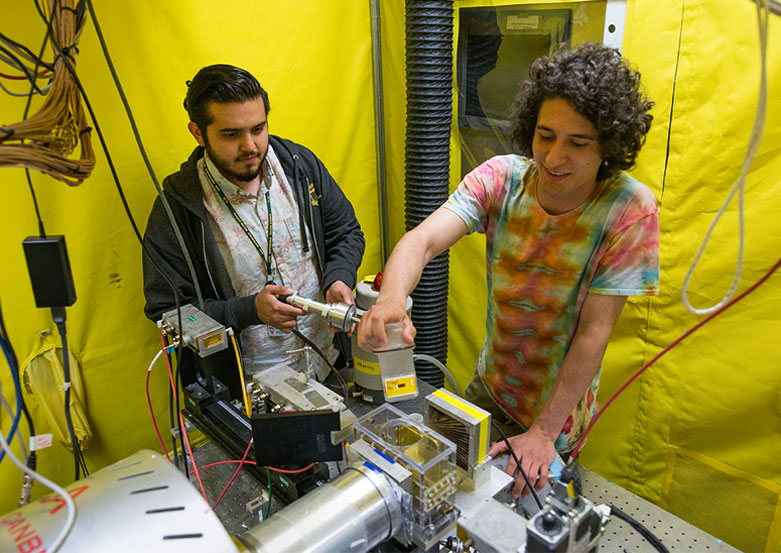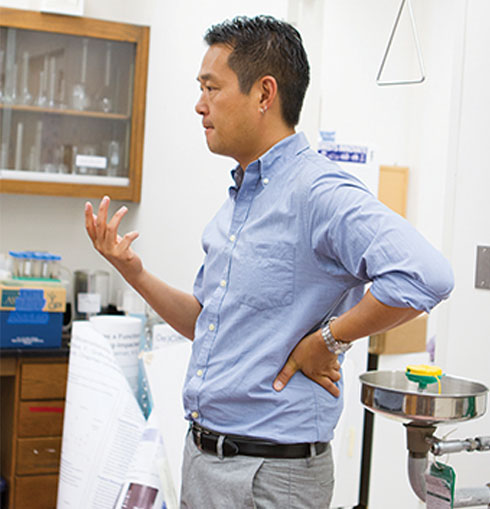100
BEAM
TIME
The testing is more than scientific for Chapman students whose environmental research takes them where few undergrads go.
Our story starts with college students running sophisticated sample analysis at 3 in the morning using beams of the brightest, most intense X-rays on earth. What could go wrong, right?
“Oh yeah, they could totally kill you,” Jessika Valenciano says of the waves of energy she and her Chapman University colleagues use for investigating environmental samples at a national laboratory operated by Stanford University.
But don’t worry, the smile Valenciano radiates tells us that this tale has a happy ending.
The senior research assistant helps manage the Kim Environmental Geochemistry (KEG) Lab at Chapman, where she’s recounting one of her first experiences with “beam time” at one of only four synchrotron radiation facilities funded by the U.S. Department of Energy. Valenciano’s mentor is Professor Christopher Kim, Ph.D., the principal investigator who leads the KEG Lab. He’s an internationally recognized environmental geochemist who studies the impact of metal contamination in natural settings.

“Oh yeah, (the X-rays) could totally kill you.”

Valenciano and the students on the KEG team learn fast that beam time is precious. They ready their samples weeks before flying to the Northern California lab so they can optimize a 72-hour continuous research window that’s rarely available to grad students, let alone undergrads. After all, this is a facility three scientists have used for testing that led to Nobel Prize-winning breakthroughs.
“With the synchrotron, we can probe the structure of our samples at the atomic level,” Kim explains. “We can identify trace concentrations of elements we’re interested in, and we can look at our samples in pretty much their native state. There’s no other instrument that can do what the synchrotron can, with this degree of resolution and detail.”
Among other things, the KEG Lab’s work helps those who clean up contaminated sites better understand how scientific tools can best be used for environmental remediation. For Kim and the lab’s student researchers, the synchrotron is a critical tool in exploring both fundamental and applied science.
“You’re a student, and you’re at this national lab with other scientists, doing research and collecting data,” Valenciano says. “It’s the kind of opportunity that sets the Chapman research experience apart.”
TESTS AND TAKEAWAYS
Because beam time at the facility is so coveted, sample analysis takes place almost around the clock, including on weekends at 3 a.m. That’s when Valenciano loaded a particular environmental sample and, after following the facility’s painstaking safety procedures, prepared to collect about six hours worth of data.

“I was waiting for what we call the edge jump – a place where the graph that’s plotting results shoots up, and we know we’re going to get meaningful data,” Valenciano recalls.
That hurdle cleared, she was planning to get a few hours of sleep, but first she stopped to chat with a lab teammate working on her own experiments at a nearby beamline. She decided to stop back by her beamline to check the progress of her sample. That’s when her heart took an edge jump of its own. She saw immediately that a component had crashed and she was getting no data.
Her first reaction was to “freak out a bit.”
“I had just wasted an hour and a half of beam time and almost went to bed and wasted six hours,” she says.
Then Valenciano remembered that a wiki is posted near each beamline to help scientists troubleshoot system problems. Following the instructions, she got the sample back up and running without having to wake anyone up for help. She even squeezed in a few hours of sleep after all.
“I know now that if it ever happens again, I can skip the freak-out and go right to the fixing,” Valenciano says. “In the moment, I wanted someone to fix things for me. But now I know it’s better to build the confidence that I could do it myself.”
It’s common for KEG Lab newcomers to be intimidated when they first use the synchrotron. Trepidation pretty much comes with the territory.
“There’s certainly reason to be cautious, and you need the guidance and training that get you certified to use the equipment,” Valenciano says. “But sometimes the only way to confirm you can do the testing is for you to be tested yourself. It’s very empowering to have that opportunity to prove yourself.”

“I know now that if it ever happens again, I can skip the freak-out and go right to the fixing … Sometimes the only way to confirm you can do the testing is for you to be tested yourself. It’s very empowering to have that opportunity to prove yourself.”

BIG LEAGUES OF RESEARCH
Professor Kim knows what it’s like to be a newbie student researcher who’s a bit overwhelmed by the synchrotron experience. After earning an environmental studies degree at Princeton, he performed research toward his Ph.D. in geological and environmental sciences at Stanford University, which is home to the Stanford Synchrotron Radiation Lightsource (SSRL).

Before graduating in 2002, Kim even snagged a lab-based locker that has since become a hub for Chapman student researchers. Each time new team members arrive at the site, they use a Sharpie to add their names to a list of KEG Lab researchers that now runs nearly the length of the locker door. It’s a rite of passage – like they’re signing into the big leagues of scientific research.
“I think they sense and then realize they’re part of a wider community,” Kim says.
Never mind that the storage locker contains things like a nonfunctioning alarm clock, a long-expired can of off-brand chili and similarly outdated caffeine tablets.
“I bet that chili’s still good,” Kim says, grinning. “But I am not willing to be the one to take that bet.”
LEGACY OF THE GOLD RUSH
Clearly, the KEG Lab team focuses on things beyond cleaning out lockers – things like advancing the understanding of environmental science.
Kim’s research focuses on abandoned mines in California, where the same processes that concentrated gold and other precious metals for miners to collect also concentrated arsenic, lead and other hazardous metals.
“It turns out these mine wastes left over from the Gold Rush have created a large environmental legacy that we’re having to deal with as potential health issues,” Kim says.
![]()
“It turns out these mine wastes left over from the Gold Rush have created a large environmental legacy that we’re having to deal with as potential health issues.”

In one branch of KEG Lab research, Kim and his students test the efficiency of a technique used to clean bodies of water that are contaminated with heavy metals. Lab researchers synthesize nanoparticles, then modify them to simulate environmental effects like freezing and drying.
“You may have a pond that’s contaminated with heavy metals, and that pond may freeze over or eventually dry up,” says Fernando Silva ’19, a KEG Lab researcher. “If you’re going to remediate, you need to know how the process will be affected by environmental conditions.”
By exposing their test samples to the high-powered X-rays of the synchrotron, they get a next-level look at possible changes in metal absorption and retention to the nanoparticles over time. The results might help to predict the effectiveness of remediation efforts and allow researchers to suggest improvements to techniques.
In support of its mine waste research, the KEG Lab has received funding from the Bureau of Land Management, Environmental Protection Agency, U.S. Geological Survey and National Science Foundation, which has presented Kim with a CAREER award – the NSF’s most prestigious recognition in support of early-career faculty.
STUDENT IMPACT
For his part, Kim says that Chapman students have long played a vital role in the success of KEG Lab research.
“The research we do allows students from different disciplines to approach it from their point of interest,” says the professor, who is also associate dean for academic programs in Chapman’s Schmid College of Science and Technology. “I benefit because they’re coming at these complex environmental geochemistry issues from different angles. They benefit because they get the opportunity to own their research – to develop an intuition that shows they’re becoming real scientists, and that serves them as they pursue their own careers in the sciences.”



![]()
“Being in the lab warmed me up to chemistry in a way that the classroom experience didn’t, I didn’t expect to enjoy research, but now I love it because you get to pursue your curiosity.”
Silva was studying art when he took one of Kim’s physical geology classes, and it wasn’t long before he was lobbying to join the KEG Lab team. He recently graduated with a degree in environmental science and policy.
“Being in the lab warmed me up to chemistry in a way that the classroom experience didn’t,” he says. “I didn’t expect to enjoy research, but now I love it because you get to pursue your curiosity.”
That love for inquiry is evident at the synchrotron, as Silva meticulously loads samples in the beamline hutch and trades insights with lab colleagues interpreting data.
He even likes to sneak a nap on a cot next to the beamline as his samples run.
“The machine gives off a hum – it’s almost peaceful,” he says. “You hear vacuums and actuators going off. It kind of lulls you to sleep.”
For members of the KEG Lab team, the bulk of beam time is anything but peaceful. The hum typically comes from the scramble to make sure tests go right, to gather and make sense of data – in general to make the most of every moment on the beamline.
Sleep is for the plane ride home.
“It can be intense,” Silva says of the synchrotron experience. “But the best part is seeing everyone come together and contribute to a bigger body of knowledge.”





